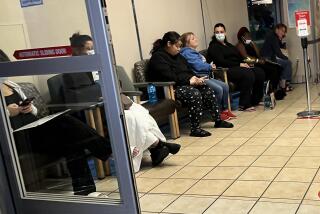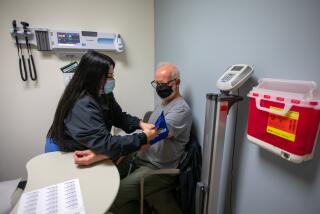Good medical care? It’s a toss-up
- Share via
It’s not the other guy.
Americans are all in the same leaky boat when it comes to receiving the standard of care for basic health conditions, according to a study in the March 16 issue of the New England Journal of Medicine. People of all colors, ages and incomes get only about 55% of the care that’s recommended.
“It doesn’t matter where you live, if you’re rich or poor, insured or uninsured, you get the right care only about half the time,” says study author Dr. Steven M. Asch, a health researcher with Rand Corp.
A 50-year-old white woman with a college degree earning $50,000 can expect to get 56.7% of recommended care, according to the study. A 50-year-old black man with less than a high school education and an income below $15,000 would receive 51.4% of recommended care.
Certainly some people have better access to healthcare than others, and previous studies have shown that people without health insurance get sicker and die younger than those with insurance. But this study wasn’t about access to care. It was about what happens after people reach a hospital or doctor’s office.
Once they’re in the door, regardless of how long it took to get there, they get what they need about half the time, regardless of who they are or even whether or how they’re insured, the study found. Recommended care included things that have been scientifically shown to be medically effective and are accepted as the best standard for various conditions. The researchers looked at 439 such measures of quality for 30 common medical conditions and preventive care.
For example, after a patient has a heart attack, doctors should prescribe a beta blocker, a follow-up treatment shown to save lives, but they do so only half the time. An anti-inflammatory steroid inhaler is the first line of treatment for someone with asthma, yet only one in two asthmatics receive a prescription when they need it. And patients have about a 50% chance of getting the right diagnostic test if they have pneumonia.
Researchers at Rand, a Santa Monica-based think tank, had previously reported that, overall, Americans get about half the health care they should be getting. “I think that study produced a kind of denial,” Asch says. “People thought that it might be true, but not in their community. What this study says is that people from all walks of life all across the country are at risk for poor quality health care.”
The new study looked for variation according to age, race, gender and income, and found very little. Researchers studied people living in 12 communities, talking to 6,712 participants and getting permission to go over their medical records. They covered a two-year period from 1998 to 2000.
The patients in the study reported seeing one to 17 doctors (the average was 2.6) over the two years. That alone, says Dr. Donald Berwick, president of the Institute for Healthcare Improvement, is one reason why quality suffers.
“Healthcare is highly fragmented. Let’s say a person with asthma or high blood pressure or diabetes sees several doctors,” says Berwick, whose organization is working to reduce the numbers of preventable deaths among hospitalized patients. “They don’t share common records, they don’t share information, and the ball gets dropped.”
Among the differences found across the demographic spectrum were that more women (57%) than men (43%) were screened for disease, but more men (59%) than women (56%) were treated for disease. Older people had better quality of care for chronic diseases than did younger people, but younger people were more likely to receive preventive care. Overall, blacks and Hispanics scored about 3.5 percentage points higher than whites did on quality of care.
But the relatively small differences among groups pale compared to the large numbers of people who aren’t getting care of proven value. “The most important misconception to get over is that idea that your care is fine -- it’s everybody else who has problems,” Berwick says.






